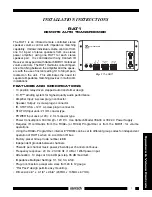
58
SD Series Technical Manual
MDS 05-4846A01, Rev. F
Terminal Server
COM1/2
Configuration
The radio’s Terminal Server feature allows IP addressing of the COM1
and COM2 serial interface ports. Data from these ports is sent over the
air as encapsulated IP packets. At the receiving end, the data is decapsu-
lated and delivered to the appropriate COM port(s). In contrast to the
radio’s IP Payload feature, having a terminal server at the Remotes
means that Ethernet data can be delivered to
specific
devices connected
to these radios. Terminal Server settings, examples, and additional ben-
efits are described in the following paragraphs.
The image below shows the Device Manager’s Terminal Server config-
uration screen. Two such screens are provided in the Device Manager;
one for COM1 and another for COM2. Here, the behavior of the ter-
minal server is set and applied. The Terminal Server must be enabled
and configured in
all
radios requiring IP encapsulation of serial data.
Proper configuration of the serial ports is also required, using the
Com-
munications Ports
section of the Device Manager.
NOTE:
Available selections vary depending on the mode selected.
•
Status
—Enables or disables the Terminal Server feature.
•
Mode
—Sets the operating mode for the IP port. It may be set to
UDP Socket
,
TCP Client Socket
,
TCP Server Socket
, or
TCP Server/Client
Socket
to match the service in which it will operate.
•
Local Radio IP Port
—Used to specify a port number for the RJ-45
modular connector on the radio’s front panel. As a general rule,
port numbers below 2000 should be avoided, as some are
reserved for special applications in data networks.
•
Destination IP Address
—Specifies the IP address associated with
the device connected through the RJ-45 modular connector on the
radio’s front panel (typically a PC). Any valid IP address may be
entered here.
•
Destination IP Port
—Used to specify a port number for the RJ-45
modular connector on the connected device (typically a PC). Port
numbers below 2000 should be avoided, as some are reserved for
special applications in data networks.
•
TCP Server IP Address
—IP address of the TCP server being used.
•
TCP Server IP Port
—Port number of the TCP server being used.
•
Connection Timeout
—Used to specify a time in seconds, after
which the connection will be dropped following a period of inac-
tivity.















































